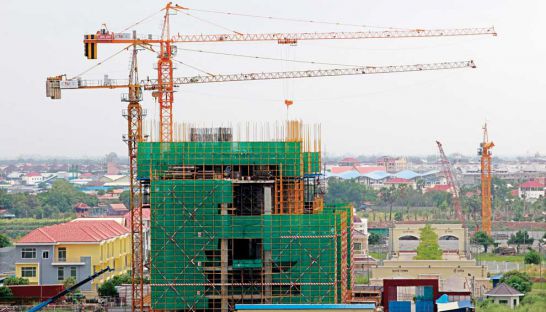Phnom Penh’s burgeoning population could tip almost 3 million
Phnom Penh’s burgeoning population could tip almost 3 million
People living in Phnom Penh are experiencing more traffic jams as the population skyrockets and the city expands, with society buckling under the government’s limited commitment to infrastructure.
Pa Socheatvong, Phnom Penh’s governor, said recently that the city’s master plan for 2035, approved last year, includes 678 square kilometres of available land area for the city’s authority to expand the villages and districts.
This expansion plan comes as a means to accommodate the population growth and overall infrastructure.
“The city’s authority is redoing the population census because there have been many people from the provinces migrating to the city these past few years, making it difficult for the authorities to manage the security because identification and infrastructure management aren’t quite well-managed.”
He added, “Boreys or houses can’t be built wherever one sees fit; they have to follow the urban planning blueprint. This is the authority’s concern, and our administrative office is still following through with the old procedures that need to be reformed.”
Socheatvong said the most pressing challenges are electricity, water and infrastructure management. According to him, the municipal authority has installed 200 kilometres of underground sewer pipes to ease up the flooding problems, and constructed 150 kilometres of concrete roads in the city’s outskirts.
Traffic congestion, nevertheless, still poses the most monumental problem, which Prime Minister Hun Sen has repeatedly talked about. The city has three types of congestion; traffic, sewage, and trash, which is why the city’s authority will be working with 300 contracted workers to aid in freeing up traffic congestion in 100 target locations within the city.
The governor also added that the population could reach three million by the end of this year.
Mean Chanyada, City Hall spokesman, said Phnom Penh will have an additional 44 villages on top of the existing 953 villages, and nine new communes on top of the existing 96 in four districts: Russeikeo, Mean Chey, Sen Sok, and Por Senchey.
He said City Hall’s decision to increase the number of villages and communes are because of the population growth and the shifting economy.
The last recorded population census was conducted in 2012, yielding a total of slightly over 1.5 million people.
“There are now some communes with over 100,000 people, which make it hard for the local authority to manage. Right now, the city is doing another census [to count the city’s entire population], which has begun since mid-June, and will finish at the end of August.”
Tous Saphoeun, deputy secretary-general of Pannasastra University’s architecture faculty, said the government should focus on investing in key infrastructure and organize short-term objectives to achieve long-term plans.
For instance, if they want to create a special economic zone by relocating factories out of the city, there has to be sufficient water, electricity and other basic infrastructure to attract more high-calibre developers.
He said, “Right now, the government has not thought well enough about this issue, which is why the industrial, commercial and residential zones are still mixing together.”
He continued, “What’s important is to let the infrastructure go ahead first, but as of now, we are not analyzing this clearly.”
Saphoeun raised the example of installing road dividers in the city, which he claims have failed to improve the traffic situation.
“Instead, 99 per cent of them create problems because we did not think about it clearly,” he said.
Dr Van Vat, an independent analyst on construction sector and an expert on land management, echoes the governor’s prediction of a population swell to three million due to a large inflow of workers.
He said the population increase in Phnom Penh will cause a range of problems including traffic congestion as well as pollution.
“The city authority has to go over and work on prioritised issues and follow through with the master plan, as well as promoting the master plan to the public, because only when the public is aware of the plan will it be effective,” Vat said.
“If the master plan can’t be implemented, it indicates the inefficiency of the authority and their management.”
Thida Ann, associate director of CBRE Cambodia, said the city is expanding, but the infrastructure is not expanding alongside the population.
If the government doesn’t think about improving the infrastructure, Sothida predicts Phnom Penh may become like Jakarta, which is known for its horror traffic jams.
She continued, “I see that the government is working with expert companies to build public infrastructure and study the side effects.”
She added, “Infrastructure in Cambodia takes a longer time to develop than any other sector, unlike in Ho Chi Minh, where they build the infrastructure before developing or investing in that area.”
Sothida added that although the infrastructure develops slower than any other development, it does not mean that the issue can’t be solved. She noted that solving Phnom Penh’s infrastructure problems, however, would be expensive and time consuming.
Pheung Sophorn, secretary of state for the MLMUPC, refused to comment.



